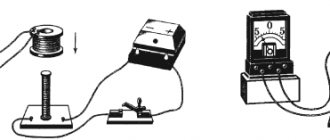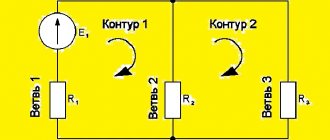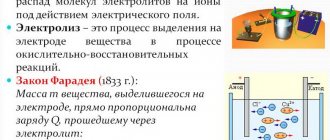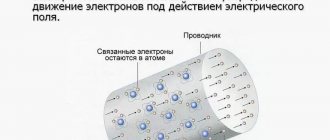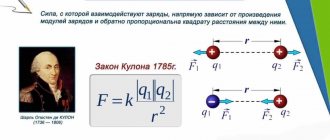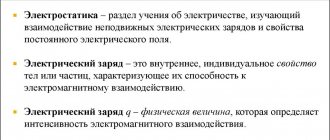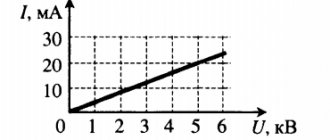First Law
If you pass an electric current through a solution of copper sulfate for a certain amount of time, a small amount of copper is released at the cathode. However, if you apply a higher current, in the same amount of time a larger amount of copper is formed at the cathode. With increasing time and the same current intensity, the amount of copper also increases.
Rice. 1. Michael Faraday.
Faraday established the relationship between the mass of a substance, current strength and time. Mathematically, this relationship is expressed as follows:
m = kIt,
Where:
- m is the mass of the substance;
- k – electrochemical equivalent;
- I – current strength;
- t – time.
An electrochemical equivalent is the mass of a substance formed when a current of 1 A passes through an electrolyte in one second. Expressed as the ratio of the mass of a substance to the amount of electricity or g/C.
The product of current and time expresses the amount of electricity: q = It. This is an electrical charge measured in coulombs (one ampere per second). Electric charge reflects the body's ability to be a source of an electromagnetic field and to take part in electromagnetic interaction.
Accordingly, Faraday's equation takes the form:
m = kq.
Rice. 2. Faraday's first law.
Faraday's first law of electrolysis: the mass of a substance released during electrolysis is directly proportional to the amount of electric current passed through the electrolyte.
Faraday's Laws of Electrolysis
In 1833 M. Faraday established:
The mass of the substance that is released when an electric current passes through electrolytes at the anode or cathode is directly proportional to the charge that is transferred by ions through the electrolyte:
m = kq,
where m is the mass of the substance, kg; q - charge, Cl.
The proportionality coefficient k = m/q is called the electrochemical equivalent of a given substance .
The electrochemical equivalent of a substance shows what mass of a substance in kilograms is released on the electrode when a current passes, carrying a charge equal to one coulomb:
k = m/q
If we keep in mind that with constant current in the circuit q = IΔt, where I is the current strength (ampere), and Δt is the time it takes for the current to pass (seconds), then Faraday’s law can be written as
m = kIΔt.
Based on modern concepts, the law for electrolysis can be established theoretically. Let charge q be transferred through the electrolyte during time Δt. The charge of one ion is q0i = ne, where n is the valence of the ion, and e is the value of the elementary electric charge. Therefore, q = neNi, where Ni is the number of ions that reached the electrode.
On the other hand, the mass of the substance released at the electrode m = m0iNi, where m0i is the mass of the ion, which can be determined from the molar mass of the substance M and Avogadro’s constant NA:
m0i = M/NA; m = (M / NA) • Ni.
From the equation for charge q = neNi, Ni can be determined: Ni = q/ne. Substituting the Ni values into the expression for mass, we get:
m = (M / neNA) • q,
which is also Faraday's law for electrolysis . So, the electrochemical equivalent of the substance
k = M/neNA,
where all quantities for a given substance are constant.
In the last formula, the value of the elementary charge e and Avogadro's constant are the same for all substances. Their product was called Faraday's constant :
F = eNA.
Faraday constant value :
F = 1.6 • 10-19 C • 6.023 • 1023 mol-1 = -9.65 • 104 C/mol.
Now for the electrochemical equivalent of a substance we have Material from the site https://worldofschool.ru
k = (1 / F) • (M / n),
which is the second law for electrolysis .
Second law of electrolysis . Electrochemical equivalents of substances are directly proportional to the masses of their moles and inversely proportional to their valencies.
To make it convenient to solve many problems, both laws can be combined in one expression ( combined law of electrolysis ):
m = (1 / F) • (M / n) • q,
or
m = (1 / F) • (M / n) • IΔt.
On this page there is material on the following topics:
Formula and formulation of Faraday's law
Faraday's law of electrolysis physics
Formula 2 of Faraday's law for electrolysis
Law of Electrolysis (1833 - Faraday
Faraday's law solving problems with cobolt
Questions about this material:
Formulate Faraday's law for electrolysis and write down its formula.
Write down the formulas for the unified law of electrolysis.
What is Faraday's constant?
Second Law
Faraday, passing an electric current of the same strength through various electrolytes, noticed that the masses of substances on the electrodes were not the same. After weighing the released substances, Faraday concluded that the weight depended on the chemical nature of the substance. For example, for every gram of hydrogen released there were 107.9 g of silver, 31.8 g of copper, 29.35 g of nickel.
Based on the data obtained, Faraday derived the second law of electrolysis: for a certain amount of electricity, the mass of a chemical element formed on the electrode is directly proportional to the equivalent mass of the element. It is equal to the mass of one equivalent - the amount of substance that reacts or replaces 1 mole of hydrogen atoms in chemical reactions:
μeq = μ/z,
Where:
- μ – molar mass of the substance;
- z is the number of electrons per ion (valence number of ions).
To release one mole equivalent, the same amount of electricity is consumed - 96485 C/mol. This number is called the Faraday number and is symbolized by the letter F.
According to the second law, the electrochemical equivalent is directly proportional to the equivalent mass of the substance:
k = (1/F) μeq or k = (1/zF)μ.
Rice. 3. Faraday's second law.
Faraday's two laws can be reduced to a general formula: m = (q / F) ∙ (μ/z).
Faraday's first law
This law was derived by scientists experimentally. It determines the proportional relationship between the mass of the substance formed on the electrode and the charge passing through the electrolytic solution.
This proportion is clearly displayed by the formula m=k x Q=k x I x t, where k is the proportionality coefficient or electrochemical equivalent, Q is the charge passing through the electrolyte, t is the charge passage time, m is the mass of the substance formed on the electrode as a result reactions.
Faraday's first law is used to determine the amount of primary products formed during electrolysis on the electrodes. The mass of this substance is the total mass of all ions that hit the electrode. This is confirmed by the formula m=m0 x N = m0 x Qq0 = m0q0 x I x t, in which m0 and q0 are the mass and charge of a single ion, respectively. N=Qq0 – determines the number of ions that hit the electrode during the passage of charge Q through the electrolyte solution.
Consequently, the value of the electrochemical equivalent k is the ratio of the mass of the ion m0 of the substance used and the charge q0 of this ion. It is known that the magnitude of the charge of an ion is the product of the valence n of this substance and the elementary charge e, that is, q0 = n x e. Based on this, the electrochemical equivalent of k will look like this: k = m0q0 = m0 x NAn x e x NA = 1F x μn. In this formula, NA is Avogadro's constant, μ is the molar mass of a given substance. F = e x NA is Faraday's constant and is 96485 C/mol.
The numerical value of this value is equal to the charge that must be passed through the electrolyte solution in order for 1 mole of a substance with the same valence to be released at the electrode. The Faraday law under consideration for electrolysis will take the form of another formula: m = 1F x μn x I x t.
What have we learned?
Faraday, carrying out the electrolysis reaction of various substances, derived two laws. According to the first law, the mass of a substance deposited on the electrode is directly proportional to the amount of electricity passed through the electrolyte: m = kq. The second law reflects the relationship between the electrochemical equivalent and the equivalent mass of a substance: k = (1/F) μeq. Electrochemical equivalent is the amount of substance released during the passage of a unit of electricity. Equivalent mass is the amount of a substance that reacts with 1 mole of hydrogen.
Michael Faraday's Laws
As a result of many studies, in 1834 the English physical chemist Michael Faraday (the unit of measurement of electrical capacitance, the farad, is named after him) derived two laws that can quantitatively describe the process of electrolysis. Although the very fact of decomposition of compounds under the influence of electricity passing through their solutions was discovered long before Faraday. In 1800, another English scientist, William Nicholson, established this fact experimentally.
Faraday's achievements in the study of electrolysis are enormous. He introduced the basic terms into physical chemistry that are still used to describe this process. The scientist’s two laws in modern formulation are presented as follows:
Mathematical formula
Both laws were obtained by Faraday experimentally. Their verbal formulations can be easily combined and translated into mathematical language. The general equation, which is convenient to use when solving any practical problems, takes the following form:
m = (Q/F)*(M/z).
Here m is the mass of the substance formed on the electrode, Q is the charge passing through the electrode during the reaction, F is the proportionality coefficient, which is called Faraday’s constant, M is the molar mass of the substance participating in the chemical reaction, z is its valency (dimensionless number).
The first factor of this equation mathematically reflects the formulated first Faraday law; accordingly, the second factor is an expression of the proportionality of the mass of a substance to its equivalent (M/z).
This formula can be transformed if we recall from the course of general physics that the charge is calculated by the formula:
Q = I*t.
Here I is the electric current in amperes, t is the time it passes through the electrolyte. Substituting this expression into the mathematical Faraday law and transforming it, you can obtain the following formulas:
m = kIt = (I*t/F)*(M/z) ==>
n*z*F = I*t.
The letter n here denotes the amount of substance released on the electrode in moles (n = m/M).
F constant value
The numerical value of Faraday's constant is approximately 96500 C/mol. The physical meaning of this value is that it tells how much electricity must be passed through the solution in order for 1 mole of a monovalent substance to be released at the electrode.
The value of F is closely related to Avogadro's constant NA and to the elementary charge of the electron e by the following expression:
F = NA*e.
This formula was used by scientists in the 19th century to accurately determine the number NA. Faraday himself determined the constant that bears his surname through studying the process of electrolysis of a silver solution.
Experiments are currently being conducted to accurately determine the value of F (and therefore NA) in order to use it to redefine the unit of mass, the kilogram.
Test on the topic
- Question 1 of 5
How is Faraday's first law formulated?
Start test (new tab)
Hall of Fame
To get here, take the test.
-
- Lisa Cipher
4/5
- Evgeny Pshenichny
5/5
- Tatiana Bataron
4/5
FARADAY'S LAWS
FARADAY'S LAWS , the basic laws of electrolysis, reflecting the general law of conservation of matter under the conditions of the flow of electrochemicals. districts. Installed by M. Faraday in 1833-34. According to the 1st law, the mass of the substance t reacted during the electrolysis process is directly proportional to the current strength I and the electrolysis time t, i.e., the amount of electricity passed Q = It (it is assumed that I does not depend on t; in otherwise, the mass m is proportional to where t1 and t2 are the moments when the current is turned on and off). According to the 2nd law, for different electrode processes with the same amount of transmitted electricity Q, the masses of the reacted substances relate to each other in the same way as the chemical equivalents of these substances. Both Faraday laws are united by one equation:
where M is mol. m. of the substance involved in electrolysis, z is the number of elementary charges corresponding to the transformation of one molecule of this substance, 1/F-coefficient. proportionality, common to all substances, F is the Faraday constant, equal to 96484.56 C/mol.
Faraday's laws are among the strict laws, but in some cases there may be apparent deviations from them caused by traces. reasons: 1) under non-stationary conditions of electrolysis, part of the electricity is spent on charging the electrical double layer; 2) if the electrolyte has electronic conductivity (for example, a solution of metallic Na in liquid ammonia), then part of the current through the electrolyte is carried by electrons, not ions, and the corresponding amount of electricity does not participate in the electrolysis process; 3) along with the main process of electrolysis, for example, the formation of metallic. Zn according to the distribution Zn2+ + 2e Zn, part of the current can be spent on the flow of parallel electrochemical. solutions, for example: 2H3O+ + 2е = H2 + 2H2O; O2 + 4e + 4H3O+ = 6H2O. Systems in which the indicated reasons for apparent deviations from Faraday's laws are completely excluded are called. coulometers; their use makes it possible to accurately determine the amount of electricity passed by the number of electrolysis products formed. Electrochemical chemicals are usually used in coulometers. r-tion Ag+ + e = Ag or 3I- = I3- + 2e.
Faraday's laws played an important role in understanding the nature of chemistry. connections and development of atomic-molecular theory. They are used to derive all equations describing electrochemical reactions. BB transformations at the interfaces between conductors of the 1st and 2nd kind (see Electrochemical kinetics). Practical Faraday's laws are used in coulometry, as well as in determining the current output of a reactor, i.e. relations theoretical the amount of electricity calculated on the basis of Faraday's laws, to the amount of electricity actually spent to obtain a given substance in the process of electrolysis.
Lit.: Antropov L.I., Theoretical electrochemistry, 4th ed., M., 1984, p. 278-86. B. B. Damascene.
43.Electrolysis. Laws of electrolysis
Electrolysis
- a physico-chemical process consisting of the release
of constituents of dissolved substances or other substances
the electrodes electrolyte
.
The ordered movement of ions in conducting liquids occurs in an electric field created by electrodes
— conductors connected to the poles of a source of electrical energy.
the anode
is the positive electrode,
and the cathode
is the negative electrode[1].
Positive ions - cations
- (metal ions, hydrogen ions, ammonium ions, etc.) - move towards the cathode, negative ions -
anions
- (ions of acid residues and hydroxyl groups) - move towards the anode.
The phenomenon of electrolysis is widely used in modern industry. In particular, electrolysis is one of the methods for the industrial production of aluminum, hydrogen, as well as sodium hydroxide, chlorine, and organochlorine compounds [ source not specified 1700 days
], manganese dioxide[2], hydrogen peroxide. A large number of metals are extracted from ores and processed using electrolysis (electroextraction, electrorefining). Also, electrolysis is the main process through which a chemical current source functions.
Electrolysis is used in wastewater treatment (electrocoagulation, electroextraction, electroflotation processes). It is used to produce many substances (metals, hydrogen, chlorine, etc.), when applying metal coatings (electroplating), and reproducing the shape of objects (electroplasty).
Faraday's first law
Faraday's first law of electrolysis: the mass of a substance deposited on an electrode during electrolysis is directly proportional to the amount of electricity transferred to this electrode. By quantity of electricity we mean electric charge, usually measured in coulombs.
In 1832, Faraday established that the mass m of a substance released on the electrode is directly proportional to the electric charge q passing through the electrolyte: if a direct current with current intensity I is passed through the electrolyte for a time t. The proportionality coefficient is called the electrochemical equivalent of the substance
. It is numerically equal to the mass of the substance released when a single electric charge passes through the electrolyte, and depends on the chemical nature of the substance.
Derivation of Faraday's law
(1)
(2)
(3)
(4)
, where z
is the valence of the atom (ion) of the substance,
e
is the charge of the electron (5)
Substituting (2)-(5) into (1), we get
where is Faraday's constant.
Faraday's second law
Faraday's second law of electrolysis: for a given amount of electricity, the mass of a chemical element deposited on the electrode is directly proportional to the equivalent mass of the element. The equivalent mass of a substance is its molar mass divided by an integer, depending on the chemical reaction in which the substance participates.
Electrochemical equivalents of various substances are treated as their chemical equivalents
.
Chemical equivalent
ion is called the ratio of the molar mass A of the ion to its valence z. Therefore the electrochemical equivalent
where is Faraday's constant.
Faraday's second law is written as follows:
where is the molar mass of a given substance formed (however, not necessarily released - it could enter into some reaction immediately after formation) as a result of electrolysis, g/mol; - current strength passed through a substance or mixture of substances (solution, melt), A; — time during which electrolysis was carried out, s; — Faraday constant, C mol−1; - the number of electrons participating in the process, which, at sufficiently large current values, is equal to the absolute value of the charge of the ion (and its counterion) that took direct part in electrolysis (oxidized or reduced). However, this is not always the case; for example, during the electrolysis of a copper(II) salt solution, not only free copper can be formed, but also copper(I) ions (at low current).


